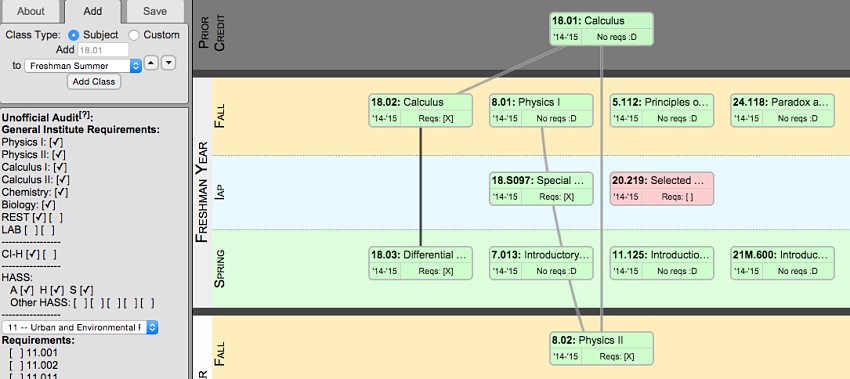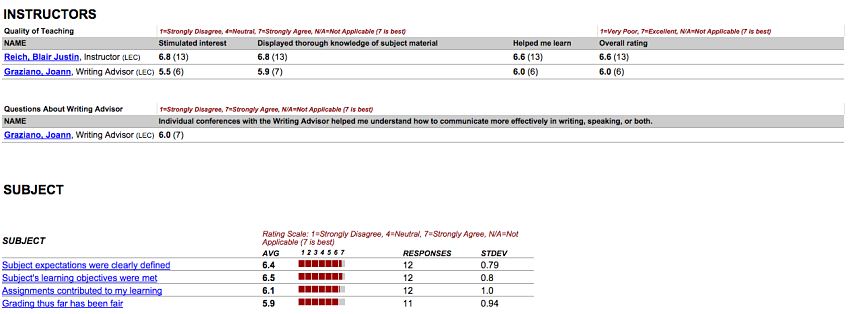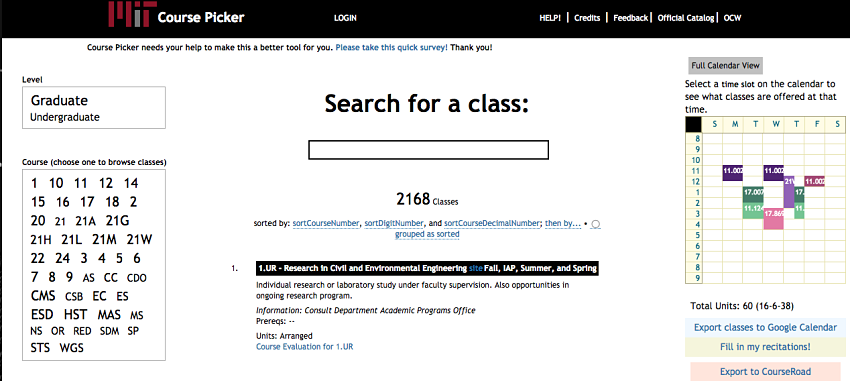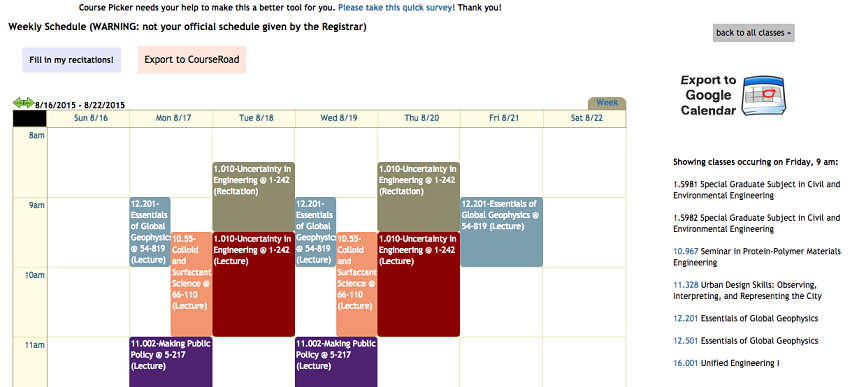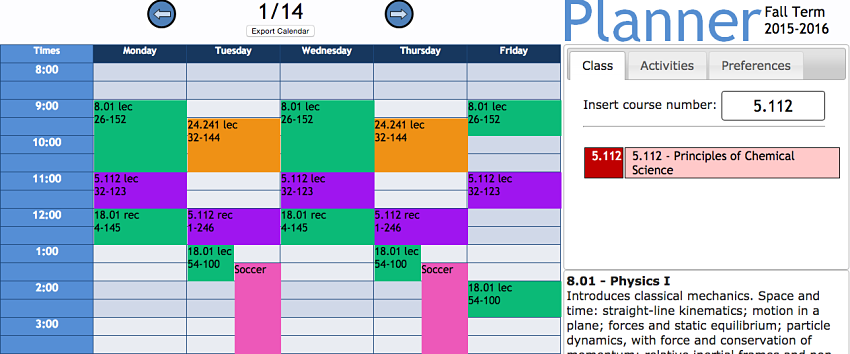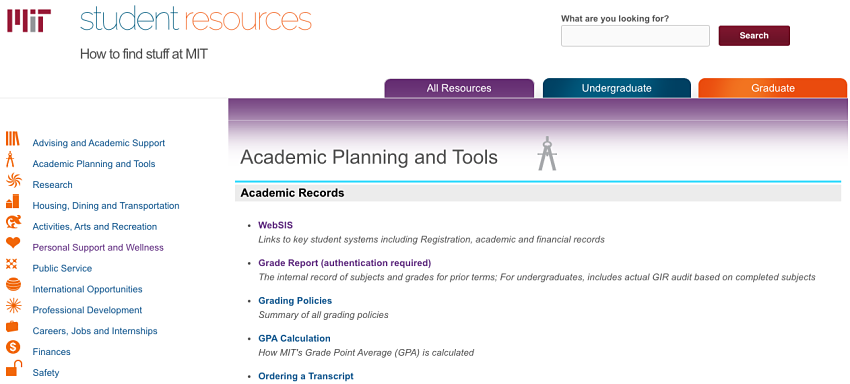Before you Register for Classes: Tools, Tips, and Resources by Yuliya K. '18
Scheduling Tools and Tips for Incoming Students
For First Semester Freshmen, Registration Day can be tough. You can only pick 54 class units, while using the precious Pass/No Record grading policy wisely.
Online Tools
Luckily, MIT has some excellent online tools for academic planning. Here are some essentials:
- CourseRoad is a “four-year planner for the MIT community” from the awesome Danny B.-D. ‘15, who wrote about it here. This is the best tool to plan your academic path at MIT. CourseRoad helps you track your progress towards graduation by checking off completed GIR, REST, Lab, and HASS classes, as well as the requirements of your specific major(s) and minor(s). You can create a tentative schedule for four years, track prerequisites, see class descriptions, move courses around, and save different paths. Check it out!
- Subject Evaluation Reports: at the end of each semester, students rate completed classes on difficulty, pace, and other factors on a scale of 0 to 7. They also rate their professors and TAs. This tool is helpful for picking courses, recitation sessions, or checking when it’s best to take a certain class. Make sure to contribute to the reports at the end of each semester. Sometimes, a professor will bring muffins for the whole class if you do.
- Course Picker: here, you can log in to save and edit your schedule for the semester, and see it displayed nicely with times and locations of your classes. This tool is integrated with CourseRoad, Google Calendar, and Subject Evaluation Reports. A great way to see if any of your classes overlap and what your school days will look like. Click around for other cool features.
- Planner is similar to Course Picker, but with an option to add extracurricular activities. You can similarly export Planner schedules to Google Calendar. Try both Planner and Picker to see which layout and features you prefer.
- MIT Student Resources is an online treasure trove that will guide you through all facets of MIT life. I wish that I’d used MIT Resources more my freshman year to learn about grading policies, majors and minors, requirements, cross-registration, finding internships, and so much more.
- ACADEX, MIT’s Center for Academic Excellence, is a helpful guide for time management, academic integrity, studying, and tutoring options. Note that there are upperclassmen tutors available for all GIRs.
Lastly, Interrogation of Upperclassmen is the #1 way to get acclimated to the new environment, find a fun community or club, and get UROP and class advice. MIT is unique for its GIR requirement — we’ve all been there. So question students on their class preferences, differences between 8.01 and 8.012 or 5.111 and 5.112, and professor teaching styles. During Orientation, professors in various departments will talk about GIR options and resources themselves. An event not to be missed.
Adding, Dropping, and (Not) Failing
If you feel overloaded in the beginning, remember that MIT’s Drop deadline is rather late into the semester. This year, it’s November 18. If you drop a class before this date, it will not show up on your transcript.
Of course, as a first-semester freshman, you probably won’t worry about dropping a class you may fail. You’re on Pass/No Record anyway! However, although a failing grade will not show up on your transcript during the first semester, the Committee on Academic Performance could still “CAP” your credit limit to 48-51 units. Same goes for subsequent semesters.
Last day to Add or switch a class is October 9. Make sure you ask the instructor for permission to get into a new class. Note that certain courses, like workshops or oversubscribed offerings, will only accept you if you show up on the first day.
Fifth Week Flags will notify you if you’re failing a certain class (something you may not realize on your own). Take advantage of the resources your professors and TAs offer after this announcement. Late Drop a class if absolutely necessary under the guidance of your Advisor and S^3 Dean.
Here are the academic standards MIT expects you to meet. Note that some of these are recommended (like completing most Science Core subjects in your first year), and some are required to not be “CAP-ped” (like the communication requirement for the first two years). In the case of the PE requirement, you’ll need to create a Physical Education Plan if you don’t complete the 8 required points by the end of your first two years.
First Semester: Exploiting Pass/No Record and GIRs
Don’t overload on required classes and GIRs during your first semester. Even though Pass/No Record time is precious, make sure you take some classes in your area(s) of interest and explore your options. Everything is presented differently in college. Don’t fear to plunge into the unknown.
The purpose of the Pass/No Record period is not so much academic, but social. MIT wants you to establish a community with your peers and try new activities.
So join an excessive number of clubs to find out how many you can actually handle. Waste time happily on a late night or early morning adventure with your friends and neighbors. Try unexpected and hard classes. Revel in the privilege of skipping that one pset at the end of the semester when you’re sure you’ll pass.
However, don’t start by neglecting the required work. Pass/No Record can be a cleverly disguised trap. With great power comes great responsibility.
Consider not taking 4 technical classes in your first semester to avoid burn-out. I made the mistake of trying to load up on “challenging” classes my fall semester to get as many GIRs as possible completed while on Pass/No Record. The plan failed, and within the first month, up until the Add date, my advisor heard from me multiple times. Each time, I shed another class or transferred to its lower-level version.
If you’re unsure whether you want to take the accelerated or regular version of a GIR, start with the “hardest” option and move down. This will account for the differences in pace. For example, I started with 18.014 my first semester. Then switched to 18.022. And finally settled on 18.02, which I enjoyed greatly. There’s no shame in switching. Plus, you get to try different flavors of a subject.
The same goes for the transitions between 8.012 and 8.01, 5.112 and 5.111, and others. As long as you transfer into the option most appropriate for you by the October 9 date, no harm will be done.
Let your future professors know you’ll be joining their class late so they can assign any makeup work. Generally, you won’t have to make up much, since transitioning between GIR levels is fairly common.
PE Requirement
Sign up for a PE class in order to fulfill the 8-point General Institute Requirement by the end of sophomore year. MIT PE says this to the Class of 2019.
Registration for PE is first come, first serve. Classes fill up quickly, so plan to wake up at the start of registration, at 8 am on September 2 for the 1st Quarter, in order to get into the desired one. This goes especially for courses required for the Pirate Certificate, which get filled within the first minute of open registration.
If you get a spot in a class, attend the first session in order to keep it and receive credit. After that, you can miss at most 3 classes, 2 of which you’ll have to make up elsewhere. Take a swim class asap if you don’t pass the swim test during Orientation.
If you don’t get into your favorite PE option, don’t despair! There’s still a chance to get in if you come by all sections of the class on the first day. Sometimes, the lucky registered students don’t make it, and the waitlisted get their chance.
Inquire about alternative options for getting PE points (such as a weekend-long hiking trip or others). Take a PE class with friends to enhance your experience.
Your Support Network: Advisor, S^3 Dean, and Others
Your Freshman Advisor is the best resource to talk about changing schedules and balancing academics and extracurriculars. This position is voluntary, so the professors who take it are truly excited to know you. They will support and advocate for you in hard times.
Maintain a good relationship with your Freshman Advisor, and he will be a great resource for academic and life advice, as well as UROP opportunities. Here is a list of what your Advisor can do for you, and what you should do to help your Advisor.
Your Assistant Advisor, an upperclassman, will be able to talk more about workload and budgeting time. Mine recommended holding a paying job for no more than 6-10 hours a week, which was wise advice.
Student Support Services (S^3) is a great resource for hard times. Establish a relationship with one of the Deans early (it is absolutely acceptable to visit different ones before settling), and you will have a trusted advocate at your side. Ask upperclassmen about their favorite advocates and ways to make the best out of each S^3 visit.
For mental and emotional support, MIT Mental Health has walk-in hours 2-4 pm on the 3rd floor of MIT Medical in E23. These services are free and confidential. And, as with S^3, you can feel free to visit several different clinicians to find one whose specialty best fits your needs.
MIT Together is an excellent website with support resources for the MIT community. Here, you can find information for a concerned friend or get immediate help for yourself.
Popular HASS Classes: How to (Maybe) Get In
Some HASS classes at MIT are traditionally full. Many of these have a CI-H/CI-HW designation. As a freshman, you will need to complete your first CI-H/CI-HW course by the end of spring, so get on the waitlist early.
Unfortunately, first-year students are usually pretty low on the HASS priority list. You don’t have a major or concentration declared. You have lots of time ahead to take classes.
So if you want to get a spot in an oversubscribed class, reach out to the instructor via email. Ask about the way she admits students to the class and indicate a strong interest in the subject. Show up on the first day of class. If more than one session of the class is offered, attend all of them. Stay on the waitlist even if all seems lost. Even if you don’t get in your first semester, the next time the class is offered, you will have higher priority if you’ve been on the waitlist.
Examples of popular CI-H classes are Course 11 education courses required for the teacher licensure program, 11.124 and 11.125. This spring, 35 students remained on the waiting list for 11.125 after the first 25 got in.
IAP Opportunities and Grading
The Pass/No Record grading policy extends to IAP, when you can take both electives and required classes for certain majors (like 8.223 for Physics). Some GIRs (like 8.01L or 18.02A) run over into the month of January, so plan your IAP activities accordingly.
The credit limit for IAP is 12 units.
Check out listings from all departments for exciting IAP options (like this one from the Edgerton Center). This year, I stumbled upon a Course 20 (Biological Engineering) class that was actually about making educational videos (incidentally, blogger Ceri R. ’16 was the TA for the class). Best decision of winter!
If you don’t want to remain on campus for the chilly January, you can apply to travel through Four Weeks for America (U.S. only) or Global Teaching Labs (eight possible non-U.S. destinations), paid for by MIT. Many other opportunities for service and travel exist. Start planning for IAP early, since some deadlines come as early as October.
Lastly, IAP is when DEX (Departmental Exploration) happens. And Charm School.
***
Ready to start your CourseRoad at MIT? Head over to the Catalog. And enjoy your first semester!!!
